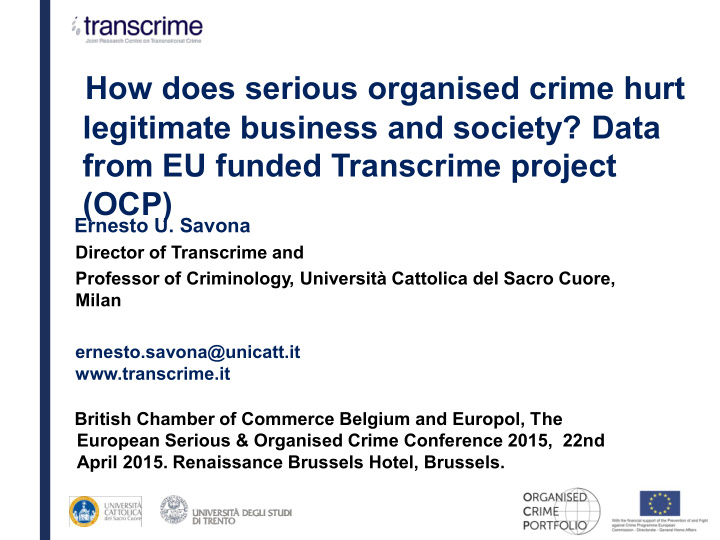



How does serious organised crime hurt legitimate business and society? Data from EU funded Transcrime project (OCP) Ernesto U. Savona Director of Transcrime and Professor of Criminology, Università Cattolica del Sacro Cuore, Milan ernesto.savona@unicatt.it www.transcrime.it British Chamber of Commerce Belgium and Europol, T he European Serious & Organised Crime Conference 2015, 22nd April 2015. Renaissance Brussels Hotel, Brussels.
Where (in what regions, assets, sectors) are the criminal proceeds invested in the legal economy? 2
In what geographic areas? Evidence of OC investments in NUTS 2; % on country total NW Italy Paris SW Scotland Madrid Southern Italy Berlin Amsterdam/Rotterdam PACA Andalusia Bucarest London Source: Transcrime – Project OCP 3
Characteristics of these areas • Areas with traditional and strong presence of criminal groups (e.g. southern Italy) • Strategic areas for illicit trafficking (e.g. Andalusia) • Border regions (e.g. south-eastern France) • Areas with important ports and airports (e.g. Rotterdam/Amsterdam) • Areas providing business opportunities (e.g. l arge urban, tourist or coastal areas and/or with a strong real estate markets) 4
Characteristics of these sectors Drivers of infiltration Characteristics of sector • Profit • Cash and labour intensive • Control the territory • Territorial-specific • Protected sector • Influence on policymakers • Key role of public • Culture, prestige and administration or public other drivers subsidies • Weak or developing • Commission or facilitation regulation of illicit activities • Front for other illicit • Conceal and facilitate illicit activities trafficking • Develop fraud schemes 5
In what types of assets? Evidence of investments in all types of assets: • Cash and other movable goods (e.g. bank accounts, jewels) • Registered assets • Cars and vans (useful to transport illicit goods) • Motorbikes (crucial for OMCGs) • Boats (to transport drugs or for THB) • Airplanes (status symbol and also used to transport drugs and illicit goods) • Real estate properties • Luxury houses (status symbol and investment) • Flats (rent and control) • Companies 6
In what business sectors? • Bars and restaurants • Construction • Wholesale and retail trade (in particular HIGHER of food products and of clothing) evidence • Transportation and logistics • Real estate activities • Hotels • Waste and scrap management • EMERGING Casinos, VLT, slot machines • sectors Renewable energy • Money transfer businesses Source: Transcrime – Project OCP 7
Which OCG invest where? - Sectors • Construction • Wholesale and retail trade • Italian mafias Bars, restaurants and Hotels • Real estate • Others (e.g. casinos, VLT and waste and scrap management) • Wholesale and retail trade (clothing and textiles) • Bars and restaurants Chinese • Transportation and logistics OCGs • Real estate • Sex, tattoo and other personal activities • Wholesale and retail trade • Russian/ Bars and restaurants • Georgian Real estate • OCGs Hotels • Casinos, VLT, slot machines • Bars and restaurants • Construction Motorcycle • Private security gangs • Wholesale and retail trade • Repair and retail of vehicles 8 Source: Transcrime – Project OCP
Why are OCG investing in the legitimate economy? • Launder criminal proceeds • Profit • Control of the territory • Infiltration into the political/administrative sphere • Social consensus • Cultural reasons • Commission or facilitation of illicit activities 9
What proceeds are confiscated? 10
The data on confiscated assets 500 Increase in the 400 number and total 300 CAB value of confiscated 200 ANBSC assets PNSD 100 0 2005 2006 2007 2008 2009 2010 2011 2012 Selected EU MS, Index 2005=100. Source: Transcrime – Project OCP 59.8% 23.9% Most confiscated assets are movable goods while 1.8% confiscated companies are almost absent 14.5% 0% 20% 40% 60% 80% EU MS covered: Finland - Patja, France - AGRASC, Ireland - CAB, Italy - ANBSC, Spain -PNSD 11 Source: Transcrime – Project OCP
The characteristics of these data • Lack of statistics on confiscated assets • Use of IT systems to organise data is very infrequent • Lack of comparability of data across countries • Data collection methods and criteria vary across EU MS • Different datasets exist in the same country • Impossible to trace an asset since the investigation stage to the final confiscation • Information on the single asset often available just in the last stage of the confiscation process 12
Final remarks Cash, bank accounts, Companies are rarely vehicles, boats and real confiscated, despite the estate are commonly collected evidence of seized criminal investments Differences emerge between what criminals invest in and what is actually confiscated Why this gap? • Investigative problems need to improve financial investigation techniques • Regulatory problems need to ease and strengthen seizure of companies • Management problems companies are not confiscated because difficult to manage 13
Conclusions: research and policy implications 14
Research and policy implications Future projects should adopt a more integrated approach 1. From information to knowledge • Shifting from macro to micro approach • Identifying criminal opportunities • Improving the collection and quality of information 2. From insight to awareness • Analysing contextual vulnerabilities • Increasing data sharing among researchers, experts and LEAs 3. From analysis to risk assessment models • Passing from cold maps to heat maps of risk • Extending the study to all 28 EU MS • Establishing public-private partnerships 15
Research and policy implications / 2 4. Revising of the confiscation tools • Improving the confiscation of companies • Enhance the management of confiscated assets by improving the regulation and in particular the management of the companies • Adopting alternative instruments to seizure (e.g. administrative penalties and temporary suspensions) 5. Reshaping LEAs, FIUs and AROs • Following the opportunity reduction approach • Focusing on high-risk situations 16
How does serious organised crime hurt legitimate business and society? Data from Transcrime-EU project Ernesto U. Savona Director of Transcrime and Professor of Criminology, Università Cattolica del Sacro Cuore, Milan ernesto.savona@unicatt.it www.transcrime.it British Chamber of Commerce Belgium and Europol, T he European Serious & Organised Crime Conference 2015, 22nd April 2015. Renaissance Brussels Hotel, Brussels.
Recommend
More recommend